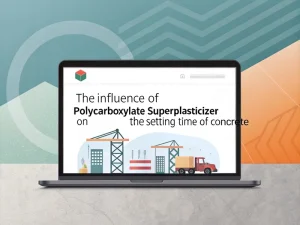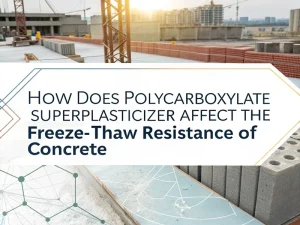
The Influence Of Polycarboxylate Superplasticizer On The Setting Time Of Concrete
Blog The influence of pol
Blog
The durability of concrete, that is, its long-term ability to resist weathering, chemical erosion, and mechanical wear, is crucial in ensuring the long-term use of infrastructure, buildings, and prefabricated components. With the continuous improvement of performance requirements for building materials, the application of high-performance additives has become crucial.
Polycarboxylate superplasticizer(PCE powder), as concrete admixtures, have become one of the core technologies for improving concrete. It is not only a tool for improving the workability of concrete, but also a key factor in fundamentally strengthening concrete structures to withstand various environments.
Polycarboxylate superplasticizer is an additive used in high-performance concrete, high-strength concrete, and high-flow concrete, belonging to the new generation of environmentally friendly water reducers. Its main component is polycarboxylate, with a solid content of about 98%. It exhibits characteristics of low dosage, high water reduction rate, good flowability and retention, and low shrinkage rate, which can enhance the durability and volume stability of concrete.
The most critical factor affecting the durability of concrete is the water-cement ratio (w/c), which refers to the mass ratio of mixing water to cementitious materials (cement plus mineral admixtures) in concrete. The lower the water-cement ratio, the fewer pores in the hardened concrete (the voids left after excess water evaporates are reduced), and the denser the structure. The efficient water reduction ability of PCE powder is the core of this mechanism.
Traditional concrete without PCE: To ensure the workability required for pouring, the construction party often uses a higher water-cement ratio (0.55-0.65). The proportion of interconnected pores inside this concrete reaches 15% -20%, becoming a “channel” for water, salt, and chemical substances to penetrate, accelerating durability degradation.
Concrete mixed with PCE powder: The polymer molecular chains of PCE can evenly disperse cement particles, reducing friction between them. This allows concrete to maintain high workability even at low water-cement ratios (0.30-0.45), resulting in a matrix porosity of only 5% -8%, and the pores are mostly in an unconnected state (fluid cannot penetrate).
Bleeding (water floating to the surface of concrete) and segregation (aggregate sinking, cement slurry floating) are common problems in traditional concrete, both of which can form internal weak areas and damage durability:
Bleeding: The pores left on the surface can cause the concrete surface to become loose and prone to peeling (surface peeling) in freeze-thaw environments.
Segregation: causing uneven structural density – excessive cement slurry in some areas (porous and fragile), and excessive aggregate in some areas (lacking bonding strength and prone to cracking).
PCE powder solves these problems through its dispersion stabilization effect:
Uniform dispersion of cement particles: PCE negatively charged polymer chains are adsorbed on the surface of cement particles, and through electrostatic repulsion, the particles are uniformly dispersed to avoid agglomeration and ensure the overall uniformity of concrete.
Reduce bleeding: The low water cement ratio reduces excess moisture, while PCE’s thickening and water retention properties can lock in residual moisture, preventing it from floating and forming bleeding channels.
The strength and durability of concrete largely depend on the “slurry aggregate interface bonding” – that is, the bonding force between cement slurry and sand or gravel. Weak interface bonding can result in microcracks, which can propagate over time and ultimately lead to structural failure. PCE powder improves the bonding strength of this interface by optimizing the cement hydration process:
Controllable hydration: PCE will moderately slow down the early hydration rate of cement (without significantly prolonging the setting time), allowing water to fully react with cement particles and generate more hydrated calcium silicate (CSH) – the “gel” responsible for bonding aggregates in cement slurry.
Uniform CSH generation: The dispersing effect of PCE evenly wraps CSH on the surface of the aggregate, forming a thicker and denser bonding layer rather than local agglomeration, thus resisting the generation of microcracks under stress.
Industrial scenes, such as factories and sewage treatment plants, or concrete in coastal areas, are exposed to corrosive environments, including acids, sulfates, and saltwater, for an extended period. PCE powder enhances the corrosion resistance of concrete through the following methods:
Reduce permeability: As mentioned earlier, the dense matrix formed by a low water cement ratio reduces pores, preventing chemical substances from penetrating into the interior of concrete and reacting with cement components (such as sulfate reacting with calcium aluminate to produce expansive substances, leading to concrete cracking).
Stabilize cement matrix: PCE polymer molecules help form a more stable CSH structure, reducing its reactivity with acids. For example, PCE concrete exposed to weak industrial acids (pH 4-5) experiences 50% less erosion weight loss within 5 years compared to concrete without PCE;
Protecting steel bars: PCE delays steel bar corrosion by blocking the penetration of water and chloride ions (from salt). Rusted steel bars can expand and cause concrete cracking, while PCE can delay the corrosion time of steel bars in coastal structures by more than 25 years.
Shrinkage cracks, caused by water evaporation (drying shrinkage) or settlement after pouring (plastic shrinkage), are subtle yet highly destructive and can become an “entrance” for water and chemicals, accelerating durability degradation. PCE powder reduces shrinkage in two ways:
Reduce plastic shrinkage: PCE extends the “plastic stage” (working state) of concrete by 15-30 minutes, giving sufficient time for the concrete to settle evenly and avoiding settlement cracks caused by rapid surface drying (such as high temperature and strong wind weather).
Reduce drying shrinkage: A low water-cement ratio reduces the amount of water that can evaporate from concrete, resulting in decreased water loss and, consequently, reduced volume shrinkage and fewer cracks. Research has shown that the drying shrinkage of PCE concrete is 20% -30% lower than that of non-PCE concrete.
The use of polycarboxylate superplasticizer (PCE) powder to enhance the durability of concrete is not simply about “increasing strength”, but rather addressing the root causes of deterioration: reducing pores, eliminating weak areas, strengthening bonding, blocking erosion, and preventing cracks. In today’s pursuit of high quality, long lifespan, and sustainable development, polycarboxylate superplasticizer is undoubtedly an ideal choice for improving concrete stability and ensuring the safety and reliability of building structures.

The Influence Of Polycarboxylate Superplasticizer On The Setting Time Of Concrete
Blog The influence of pol

How Does Polycarboxylate Superplasticizer Affect The Freeze-thaw Resistance Of Concrete?
Blog How does polycarboxy